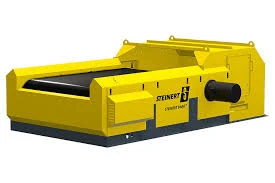
10 月 . 13, 2024 05:43 Back to list
How to Build an Eddy Current Separator
An Eddy Current Separator (ECS) is an essential piece of equipment in the recycling and waste management industry, specifically designed to separate non-ferrous metals from other materials. This technology utilizes the principle of eddy currents to effectively identify and separate metals such as aluminum, copper, and brass from non-metallic materials. In this article, we will discuss how to build an eddy current separator, outlining the materials required, the setup process, and some tips to optimize its performance.
Materials Required
Before you start building your ECS, it’s crucial to gather the necessary materials
1. Magnetic Drum The core component that generates the magnetic field necessary for separation. 2. Conveyor Belt To transport material through the separation system. 3. Power Supply A reliable source to power the magnetic drum and any motors involved. 4. Frame and Housing Steel or aluminum to create a sturdy structure to hold all components together. 5. Eddy Current Rotor A rotor designed to produce a fluctuating magnetic field that induces eddy currents in conductive materials. 6. Control Panel For operating the ECS and allowing adjustments to parameters such as speed and power. 7. Pulleys and Belts For the mechanical movement of the conveyor and drum. 8. Sensors and Sensors For detecting the presence of metals.
Building Process
1. Designing the Layout Start with a design drawing of your ECS, laying out where each component will be placed. Keep in mind the flow of materials, ensuring that they move smoothly from the feed area to the discharge area.
2. Constructing the Frame Using your chosen materials (steel or aluminum), construct a sturdy frame based on your design. This frame will support the conveyor belt and the magnetic drum, and must be robust enough to handle the stresses of operation.
3. Installing the Conveyor Belt Attach the conveyor belt to the frame. Make sure that it moves freely and is properly aligned with the magnetic drum. The belt should be of sufficient width to carry the materials and resist wear.
4. Setting Up the Eddy Current Rotor Install the eddy current rotor within the magnetic drum. It is essential to mount it securely to ensure it functions correctly when the machine operates.
5. Wiring the Power Supply Connect the power supply to the magnetic drum and the control panel. Make sure all wiring is safe and compliant with electrical standards to avoid hazards.

6. Adding Control Systems Install your control panel with various switches and controls for speed and power adjustments, as well as any necessary sensors. These allow for real-time monitoring and adjustments during operation.
7. Final Assembly and Testing Once everything is installed, check all connections and alignments. Perform a dry run with no materials to ensure that the ECS operates as intended. Watch for any unusual noises or movements, which might indicate misalignment or other issues.
Operating and Optimizing the ECS
To ensure your eddy current separator operates effectively, follow these operational tips
1. Material Preparation Before feeding materials into the separator, make sure they are free of moisture and have been physically sized if necessary. This will improve the efficiency of the separation process.
2. Adjusting Settings Regularly adjust the speed of the conveyor belt and the power of the magnetic drum based on the type and volume of materials being processed. Trial and error will help you find the optimal settings.
3. Regular Maintenance Like any machinery, regular maintenance and cleaning of the ECS will prevent potential breakdowns. Check for wear and tear on the conveyor belt and rotor regularly.
4. Monitoring Performance Use sensors to monitor the efficiency of separation. Take notes on how well the system is separating metals and adjust parameters accordingly.
5. Training Operators Ensure that personnel operating the eddy current separator are well-trained in its use and maintenance. They should be familiar with troubleshooting techniques to address minor operational issues swiftly.
Conclusion
Building an eddy current separator is a rewarding project that can significantly enhance recycling capabilities. By following the materials list and the necessary steps outlined above, you can create an efficient system for separating non-ferrous metals from various waste streams. Don’t forget the importance of maintenance and training to maximize the effectiveness of your new equipment.
Latest news
Unveiling the Power of Eddy Current Separator
NewsSep.25,2024
Transform Your Home Recyclin:home metal shredder
NewsSep.25,2024
The Future of Waste Management with Recycling Line Picker
NewsSep.25,2024
The Benefits of a Metal Recycling Plant
NewsSep.25,2024
Revolutionize Material Separation with Onwang Technology
NewsSep.25,2024
Innovative Waste Management: Unveiling the MSW Sorting Plant
NewsSep.25,2024